[1]
J. Montesano, K. Behdinan, Z. Fawaz, Ch. Poon, Considerations for Progressive Damage in Fiber-Reinforced Composite Materials Subject to Fatigue, Lecture Notes in Computer ScienceVolume 5976 (2010) 148-164.
DOI: 10.1007/978-3-642-12659-8_12
Google Scholar
[2]
H. Mao, S. Mahadevan, Fatigue damage modeling of composite materials, Composite Structures 58 (2002) 405-410.
DOI: 10.1016/s0263-8223(02)00126-5
Google Scholar
[3]
R. Talreja, A continuum mechanics characterization of damage in composite materials, Proceedings Royal Society London A399 (1985) 195-216.
Google Scholar
[4]
T.P. Philippidis, V.A. Passipoularidis, Residual strength after fatigue in composites: Theory vs. experiment, International Journal of Fatigue 29 (2007) 2104-2116.
DOI: 10.1016/j.ijfatigue.2007.01.019
Google Scholar
[5]
K.I. Tserpes, P. Papanikos, G. Labeas, Sp. Pantelakis, Fatigue damage accumulation and residual strength assessment of CFRP laminates, Composite Structures 63 (2004) 219-230.
DOI: 10.1016/s0263-8223(03)00169-7
Google Scholar
[6]
M. M. Shokrieh, L. B. Lessard, Multiaxial fatigue behaviour of unidirectional plies based on uniaxial fatigue experiments II, Experimental evaluation, International Journal of Fatigue 19 (1997) 209-217.
DOI: 10.1016/s0142-1123(96)00068-0
Google Scholar
[7]
S.W. Tsai, Strength and Life of Composites, Stanford University, Composites Design Group, Stanford, CA, (2008).
Google Scholar
[8]
P.F. Liu, J.K. Chu, S.J. Hou, J. Y Zheng, Micromechanical damage modeling and multi-scale progressive failure analysis of composite pressure vessel, Computational Materials Science 60 (2012) 137-148.
DOI: 10.1016/j.commatsci.2012.03.015
Google Scholar
[9]
F. Wang, J. Ding, Z. Chen, Statistical Analysis of the Progressive Failure Behavior for Fiber-Reinforced Polymer Composites under Tensile Loading, Polymers 6 (2014) 145-159.
DOI: 10.3390/polym6010145
Google Scholar
[10]
M.I. Shahid, Progressive Failure Analysis of Laminated Composites Subjected to In-plane Tensile and Shear Loads, PhD Dissertation, Stanford University, Department of Civil Engineering, Stanford, CA, (1993).
Google Scholar
[11]
ASTM D3479, Standard Test Method for Tension-Tension Fatigue of Polymer Matrix Composite Materials, ASTM Standard D 3479/D 3479M – 96 (Reapproved 2002).
Google Scholar
[12]
ASTM D3039, Standard Test Method for Tensile Properties of Polymer Matrix Composite Materials, ASTM Standard D 3039/D 3039M – 00.
Google Scholar


